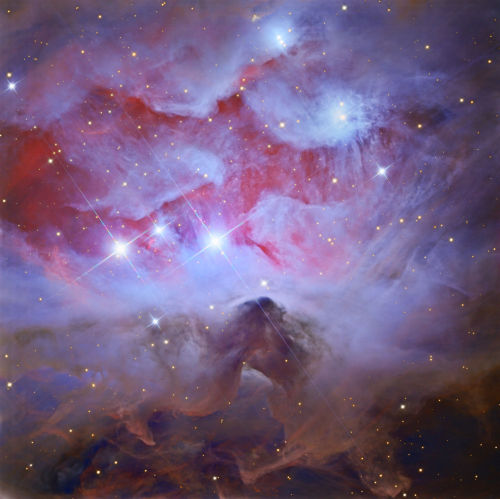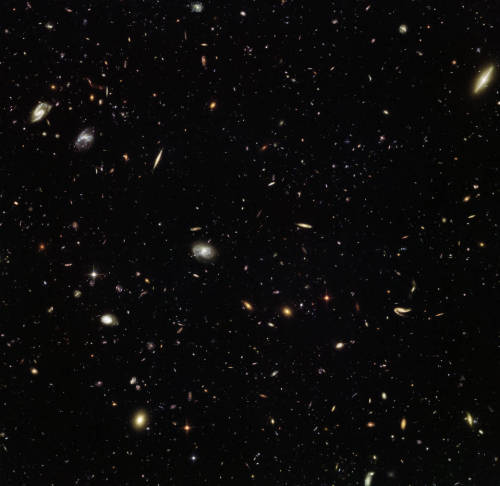Orion Nebula From HAWK-1 Js

Orion Nebula from HAWK-1 js
More Posts from Littlecadet-biguniverse and Others

Milky Way from Lake Cuyamaca js

Nebula NGC 3603
js



MARTIAN STORMS - Seen in 1977 by the Viking 2 Orbiter
“Like its predecessor, the Viking 2 mission consisted of a lander and an orbiter designed to take high-resolution images, and study the Martian surface and atmosphere. Both the Viking 1 and 2 landers benefited greatly from their orbiting counterparts, which snapped images that helped mission controllers navigate the landers to safe landing sites.”
This particular image was taken by the Viking 2 Orbiter and shows a massive dust storm on the red planet. This spectacular storm can be seen on a global scale. The Viking 2 mission would end 3 years later on April 11, 1980.
Credit: NASA/JPL

Running Man Nebula
js

M8 // Lagoon Nebula (left of center) & M20 // The Trifid (bottom)
Solar System: Things to Know This Week
Our solar system is huge, so let us break it down for you. Here are a few things to know this week:
1. We’re Going In

To be honest, Jupiter is kind of a monster. Not only is it the biggest planet in the solar system, but it also wields the most dangerous radiation and other powerful forces. Despite the risks, our Juno probe is going in close, because Jupiter also holds precious clues to how the planets formed, including our own. Arrival date: July 4. Watch the Juno mission trailer video HERE.
2. Moon Maps

The moon is beautiful in the sky, and also up close—sometimes even in the maps that scientists use to study its surface. Here are some evocative maps that lunar geologists have drawn up to chart the landscapes in the moon’s dramatic Tycho Crater. Take a look HERE.
3. That’s No Moon…Sort Of

The full moon we’ll see this week is not Earth’s only companion in space. Astronomers have discovered a small asteroid in an orbit around the sun that keeps it near the Earth, where it will remain for centuries. But it’s not exactly a second moon, either.
4. Power Blast

Venus has an “electric wind” strong enough to remove the components of water from its upper atmosphere, which may have played a significant role in stripping Earth’s twin planet of its oceans, according to new results from the European Space Agency (ESA) Venus Express mission by NASA-funded researchers.
5. How Green (Well, Red) Was My Valley

“Marathon Valley” slices through the rim of a large crater on Mars. It has provided fruitful research targets for our Opportunity rover since July 2015, but now the rover’s team is preparing to move on.
Want to learn more? Read our full list of the 10 things to know this week about the solar system HERE.
Make sure to follow us on Tumblr for your regular dose of space: http://nasa.tumblr.com


Centaurus A. Same object. Different wavelengths.
It’s scary to think most of our universe is invisible to us

Solar filaments a.k.a. prominences – when observed at the solar limb (above), are long clouds of partially ionized plasma suspended above the Sun’s surface by strongly sheared magnetic structures, called filament channels, that can support the dense plasma against solar gravity. Filaments may form at various locations on the Sun, however, they are always found within preexisting filament channels above polarity inversion lines which separate areas of opposite magnetic polarity regions.
Credit: NASA/SDO/LMSAL

Hubble peers billions of light years away, uncovering thousands of colorful galaxies clustered together in the constellation of Leo (The Lion). Galaxy clusters are so massive that their immense gravity warps and amplifies the light from more distant objects. This phenomenon, known as gravitational lensing, can help astronomers reveal the earliest galaxies in our universe.
-
 nerdsgaysandarcherybabes liked this · 3 years ago
nerdsgaysandarcherybabes liked this · 3 years ago -
 kindafondawanda reblogged this · 3 years ago
kindafondawanda reblogged this · 3 years ago -
 ohshitwrongdroids reblogged this · 3 years ago
ohshitwrongdroids reblogged this · 3 years ago -
 mee-o0ww liked this · 3 years ago
mee-o0ww liked this · 3 years ago -
 realnerdyboy reblogged this · 3 years ago
realnerdyboy reblogged this · 3 years ago -
 realnerdyboy liked this · 3 years ago
realnerdyboy liked this · 3 years ago -
 norwegianforestcat reblogged this · 3 years ago
norwegianforestcat reblogged this · 3 years ago -
 squeackygee liked this · 4 years ago
squeackygee liked this · 4 years ago -
 theinfiniteessence liked this · 4 years ago
theinfiniteessence liked this · 4 years ago -
 ownlens reblogged this · 5 years ago
ownlens reblogged this · 5 years ago -
 killingzodiac liked this · 5 years ago
killingzodiac liked this · 5 years ago -
 eastern-wind liked this · 6 years ago
eastern-wind liked this · 6 years ago -
 jeebssred liked this · 6 years ago
jeebssred liked this · 6 years ago -
 insidiousclouds-2 liked this · 6 years ago
insidiousclouds-2 liked this · 6 years ago -
 dancewiththedevil101 liked this · 6 years ago
dancewiththedevil101 liked this · 6 years ago -
 therealsirsticker liked this · 6 years ago
therealsirsticker liked this · 6 years ago -
 cripple-cat liked this · 6 years ago
cripple-cat liked this · 6 years ago -
 16fahri liked this · 6 years ago
16fahri liked this · 6 years ago -
 achilles--hell liked this · 6 years ago
achilles--hell liked this · 6 years ago -
 smallfryingpan liked this · 6 years ago
smallfryingpan liked this · 6 years ago -
 cutelovebird liked this · 6 years ago
cutelovebird liked this · 6 years ago -
 cutelovebird reblogged this · 6 years ago
cutelovebird reblogged this · 6 years ago -
 amandathescarlet liked this · 6 years ago
amandathescarlet liked this · 6 years ago -
 infantilniq liked this · 7 years ago
infantilniq liked this · 7 years ago -
 pseudogeeni reblogged this · 7 years ago
pseudogeeni reblogged this · 7 years ago -
 hopnag liked this · 7 years ago
hopnag liked this · 7 years ago -
 body-made-of-flowers-and-stars reblogged this · 7 years ago
body-made-of-flowers-and-stars reblogged this · 7 years ago -
 nonbinarytits reblogged this · 7 years ago
nonbinarytits reblogged this · 7 years ago -
 manuphiie reblogged this · 7 years ago
manuphiie reblogged this · 7 years ago -
 manuphiie liked this · 7 years ago
manuphiie liked this · 7 years ago -
 elf-ertgrl liked this · 8 years ago
elf-ertgrl liked this · 8 years ago -
 barkentinedaedalist reblogged this · 8 years ago
barkentinedaedalist reblogged this · 8 years ago -
 theshadowofmysoul7-blog reblogged this · 8 years ago
theshadowofmysoul7-blog reblogged this · 8 years ago -
 theshadowofmysoul7-blog liked this · 8 years ago
theshadowofmysoul7-blog liked this · 8 years ago -
 galaxctichoe liked this · 8 years ago
galaxctichoe liked this · 8 years ago -
 ryanthelionheart reblogged this · 8 years ago
ryanthelionheart reblogged this · 8 years ago -
 ryanthelionheart liked this · 8 years ago
ryanthelionheart liked this · 8 years ago -
 candaceterberg liked this · 8 years ago
candaceterberg liked this · 8 years ago
GREETINGS FROM EARTH! Welcome to my space blog! Let's explore the stars together!!!
144 posts